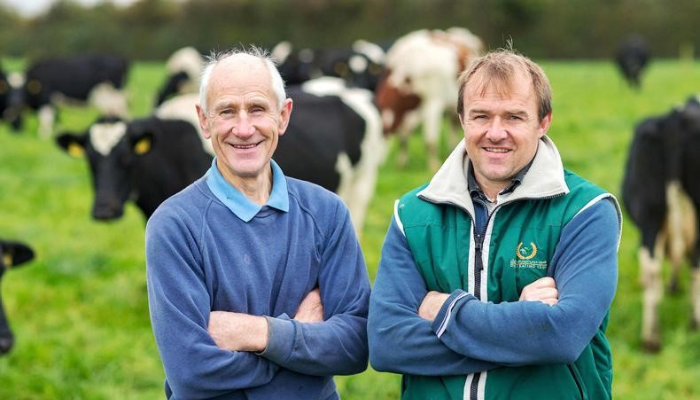17 October 2023
Edwin Thompson is making strides in increasing the sustainability of his farm

Edwin Thompson and his family farm 87 hectares in Kilmore House, Golden, Co. Tipperary. Milking 160 cows, Edwin grew 13 tonne DM/ha in 2022 and produced 521kg of milk solids per cow. Liam Quinn, Signpost Programme Advisor, tells us more about Edwin’s farm.
A participating Tipperary Co-op / Teagasc Signpost farmer Edwin is making strides in increasing the sustainability of his farm.
The farm has transformed in the last number of years with a focus on incorporating white clover into swards, contributing to a reduction in chemical nitrogen fertiliser. Teagasc research has shown that white clover has the ability to fix up to 100 kg N/ha on dairy farms through nitrogen fixation. Nitrogen fixation is the process whereby white clover can fix nitrogen from the atmosphere and make that nitrogen available for plant growth. The use of white clover has the ability to reduce nitrous oxide emissions by 40%, increase milk solid production by 20-48kg/cow/year and increase net farm profit by €108-305/ha.
A recent clover score of Edwin’s farm showed that 51% of the milking platform scored (High 20% +) for clover content, 23% scored (Medium 11-20%) and 26% of the farm scored (Low 1-10%). White clover needs a soil temperature of 9 degrees before growth commences in comparison to grass, which needs a soil temperature of 6 degrees. Therefore, the reduction of chemical nitrogen is targeted from May – September when clover is present in the sward. With clover content this high, it is no surprise that there has been a 40% reduction in chemical nitrogen fertiliser use on Edwin’s farm.
A mixture of over-sowing white clover and fully reseeding paddocks with a white clover/grass mix is practised on the farm in an effort to increase clover content. When picking paddocks for over-sowing, Edwin focuses on paddocks that have a low weed burden, high soil fertility and have good annual tonnage for grass growth. Annual tonnage reports can be accessed using pastureBase and are effective in identifying the high and low performing paddocks. Poorer performing paddocks are targeted for a full reseed with high soil fertility levels also in priority when being identified. In talking to Edwin, he emphasises that soil fertility is key in having clover established and maintained. Edwin says, “Going back the years our soil fertility would not have been as good as it is now and this is where we struggled with clover in the past”. Soil fertility on the farm shows 75% of the farm optimum for pH, 54% optimum for phosphorous and 67% optimum for potassium. Throughout the summer, the grass clover swards are targeted with 3,000 gallons of soiled water and they receive slurry based on soil test results to maintain soil fertility. All slurry and soiled water have been tested through the Signpost Programme so Edwin knows the exact amount of nutrients being applied in each round.
In 2023, a decision was made to sow multi-species swards on 3 hectares of the milking platform. Edwin is impressed with how the crop has performed and how well cows have adapted to the crop. Edwin highlights that “Cows have maintained if not improved production while grazing the multispecies swards”. The multispecies swards have worked so well that Edwin has plans to incorporate more of the crop into the milking platform in 2024. Another focus for 2024 will be on targeting paddocks with medium clover content scores. Edwin feels that with better management these paddocks can be increased from a medium to a high clover content. This management includes avoiding carrying big covers over the winter and grazing these paddocks at low covers throughout the grazing season next year. Both of these practises will allow light to the base of the sward and give the clover every chance of improving. Going forward, Edwin intends to reduce his chemical nitrogen fertiliser use further, and does not rule out the possibility of being free from chemical nitrogen on the farm in years to come.
Edwin’s farm sustainability report shows that between 2021 and 2022 greenhouse gas emissions have reduced by 3% and ammonia emissions have reduced by 4%. Nitrogen Use Efficiency (NUE) is a key environmental indicator that has also increased from 30% to 39%. This is largely influenced by reduced chemical nitrogen, because of the high clover content on Edwin’s farm.
Find out more about Signpost Sustainability Month 2023
